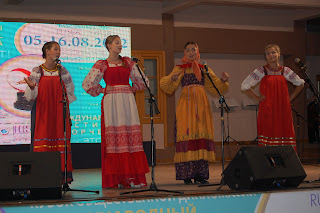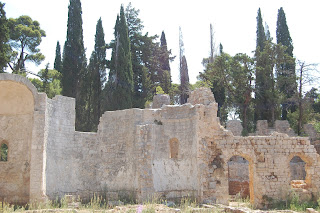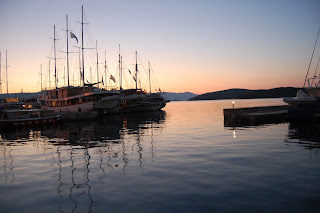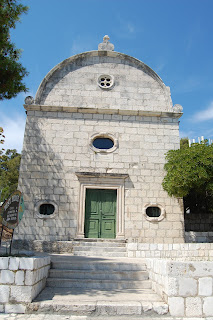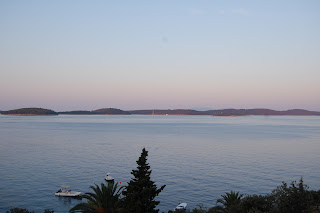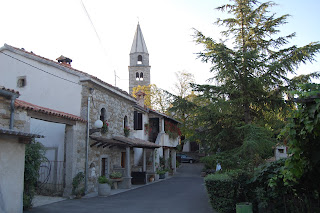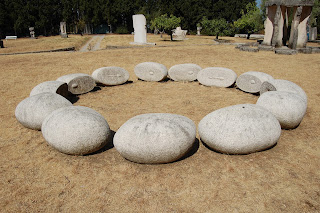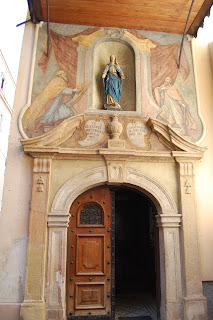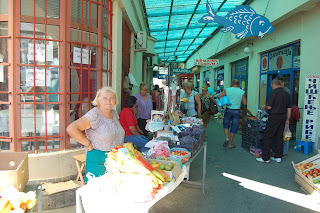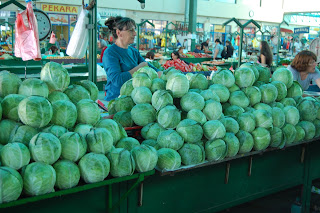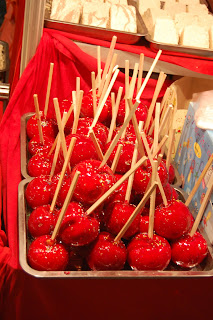 |
CLICK ON PICTURE TO SEE THIS POST
We began our four-week trip in Belgrade, Serbia on the 4th of August, 2012. Our plan was to stay a couple of days in Belgrade before taking a bus to Guča (via Čačak) for a few days at the Trumpet Festival. Then an overnight bus through Montenegro to Croatia at Dubrovnik. A couple of days there before island hopping on ferries along the Adriatic from Korčula to Hvar to Split. Then to rent a car for a week visiting Pitvice Lakes Park and from there to Istria with day trips to Trieste. Drop the car in Zagreb and take a train to Belgrade where we would get a car for our final weekend in Jagodina and Požarevac.
Along the way we discovered Art in all our destinations. Sometimes in museums, others on the streets.
But before exploring for Art, we grabbed a tram for a ride to the Hippodrome, on the outskirts on the city. Racing only takes place on Sunday afternoons and, at times, we wondered if the racing would ever get started on this day as the old place looked pretty dead when I thought the races should be going on.
Eventually, however, the races began: harness then thoroughbreds.
There were several restaurants at trackside as well as windows for taking bets, but the place was pretty much of a mess. The race announcer was a woman with a husky voice that was entertaining.
There were several restaurants at trackside as well as windows for taking bets, but the place was pretty much of a mess. The race announcer was a woman with a husky voice that was entertaining.
Art is where you can find it in Belgrade. We began at the Kalemegdan Park where the River Sava joins the Danube. It is the site of an ancient fortress, museums, a zoo, children's rides, playgrounds, clay courts and other recreational facilities. There are also lots of statues, sculptures and an art pavilion.
Unfortunately, I couldn't find anything on display worth posting here. It was a tired looking building. The Awakening by Dragomir Arambašić is out in front, however:
 |
| The Struggle by Simeon Roklsandic, 1917 |
Ivan Meštrović is well-represented in Kalemegdan with his Monument of Gratitude to France:
Angel of Death:
and The Victor which he did to commemorate the victories over the Ottomans and the Austro-Hungry Empire.
I will have more on Meštrović later. There was a project called Art 2 Sit On, consisting of several artworks/couches:
 |
| The Victor by Ivan Meštrović, 1912 |
Most were dirty, not at all inviting to sit upon.
Belgrade's big museums have been closed for at least ten years with no signs of opening again. I'm referring to the National Museum and the Museum of Contemporary Art.
We found lots of Art on the streets, such as this terra-cotta, Teratorija na Belefu exhibition out on Knez Mihailova Street:
And more sculpture around town:
 |
| by Olja Ivanjicki |
 |
| from the Skadarlija district |
 |
| caryatids by Ivan Meštrović in an entrance-way to the National Museum |
We were apprehensive before our visit to the zoo. I expected inadequate housing, but Marie thought it would be a good way to see some of the animals close up and do some sketching. The famous white tigers have a pretty nice space, but still look sad.
But not as much can be said for that of the tethered hawks, over-crowded wolves, or pathetic elephant, giraffe, and camels. The worst was the cement slope that was the brown bear habitat. The larger bear sat up with it's paws on the big iron bars and stared out. Couldn't take a picture.
On the zoo's walls are mosaics of animals. I counted 441 individual portraits mounted in groups or by themselves. Some of the artists are well-known such as Dušan Džamonja, and besides the usual and exotic animals, there was one of Warner Brothers' Tazmanian Devil and another of Garfield the Cat.
We began the next day at the Gallery of Frescoes, which doesn't actually have any frescoes at all. There are photographs and reproductions of frescoes. And there are plaster casts of famous church portals. There were super-accurate models of historically important churches throughout Serbia. We know this because one of the modelers, Nikola Markovic, was there to tell us.
We found the unmarked Tomb of Sheik Mustapha (15th century dervish from Bagdad).
and from there to the Zepter Museum on Knez Mihajilova. This is a new museum which opened in July, 2011 for the collections of Mrs. Madlene Zepter, and was formerly a bank building.
The Art was contemporary Serbian and filled three floors. While we didn't see much that we really liked, the visit was pleasurable.
and from there to the Zepter Museum on Knez Mihajilova. This is a new museum which opened in July, 2011 for the collections of Mrs. Madlene Zepter, and was formerly a bank building.
 |
| The Red Gallery |
The Art was contemporary Serbian and filled three floors. While we didn't see much that we really liked, the visit was pleasurable.
 |
| Olga by Olya Ivanijicki |
CLICK HERE TO FOR A FEW MORE.
While searching for the City Library Art Gallery, we came upon a gallery on Knez Mihajilova that was not open on Monday. There was no indication what the name of the establishment might have been, nor could we determine the name of the artist as everything was in Cyrillic. The gallery was a large space with white walls and big windows facing on the pedestrian way. The show consisted of one woman's drawings and pastels from the mid-1930s into 1970s, but they wouldn't let me take photos.
We did eventually find the library, but the Art inside was student design work which I chose not to shoot.
While searching for the City Library Art Gallery, we came upon a gallery on Knez Mihajilova that was not open on Monday. There was no indication what the name of the establishment might have been, nor could we determine the name of the artist as everything was in Cyrillic. The gallery was a large space with white walls and big windows facing on the pedestrian way. The show consisted of one woman's drawings and pastels from the mid-1930s into 1970s, but they wouldn't let me take photos.
We did eventually find the library, but the Art inside was student design work which I chose not to shoot.
Then we hopped an electric bus for a ride to the Western suburbs. Home of the University Hospital, many national embassies, and the Gallery-Legacy of Milica Zoric and Rodoljub Colakovic. Admission was free.
There was an exhibition entitled: Civic Modernism and Popular Culture - Episodes of the Stylish, the Fashionable and the Modern (1918-1941).
+by+Petar+Dobrovic,+1928.jpG) |
| Devojka u progastom kostimu (Girl in a Striped Bathing Suit) by Petar Dobrović, 1928 |
+by+Veljko+Stanojevic,+1924.JPG) |
| Kupacice (Bathers) by Veljko Stanojević, 1924 |
In addition to these and other paintings, they played a restored video of Josephine Baker in The Siren of the Tropcs (1927). Wonderful! Here's a bit of it I found online:
Upon our return to the center, we went in search of Paja Jonanović's museum. We had an address, but no one was able to help us as we walked up and down every street in the area including an art historian working as a waiter and proprietors of two art supply stores.
There were more unmarked sculptures, however:
And there were the Dragačevo-style bands performing. Typically each band will have 3 or 4 trumpet players, 2 alto horns, 2 baritone horns, 1 bass horn, 1 bass drum/cymbal, and 1 snare drum. The trumpets do not have the piston valves most are familiar with. Rather the horn is played lying on its side with rotary valves like those on the French horn. The other horns are similar to those we play here, but the bells face in a different way. The bass drummer without a snare player will use a thin, hard stick with his left hand to simulate another drum sound. Bands from around the world: Balkan, Russia, Portugal, Brazil, France, Italy and more, performed over the week.

Afterwards, Marie wanted another shot at swimming, so we stopped at a beach right along the way.
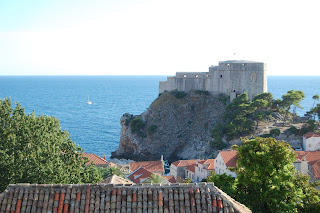

Our room was again just outside of town, but this was our view:
There was one nice Art gallery, but this was about it for Art in Korčula:
Then we were off to Hvar on the neighboring Hvar Island. Even more upscale than Korčula and a smaller old town with just a few alleyways running off St. Stephen's Square. The old fortress overlooks the town.
There were the views from our room which was a twenty-minute walk from the square. But a nice walk.
We walked past a couple of large resorts on our way to the town and it was evident that many stayed in their luxury hotels or on their yachts, though there was also a cruise ship offshore that was ferrying in visitors. Art was where you could find it. In a restaurant,
Or in the shops,
We rented a small boat and spent a morning cruising among the scrubby Pakleni Islands,
It was just a small motor, but enough to get a better look. There was supposed to be one island just for naturists, but I didn't see anyone.
Our last ferryboat ride took us to Split.
Centered around Diocletian's Palace (3rd-4th century CE) (above), Split has a distinctly Roman feel about it. The market was massive, but we came to Split to see some Art.
After a quick stop to get our rental car, our next stop was the Gallery of Ivan Meštrović.
You may have gathered by now that Meštrović was a fairly important figure in Croatian Art. Even more, he was important to Yugoslavia, as his sculpture adorns Serbia as well as Croatia. His work was created during the Nouveau and Deco periods and he was most successful, receiving numerous commissions for monuments. Unhappy with the policies of Marshal Tito, after WWII he emigrated to the US where he taught at Notre Dame and Syracuse Universities (where we first discovered Meštrović's Art). He died in South Bend, Indiana in 1962. To give an idea of the stature he had attained, in 1954 when he was granted citizenship in the United States, President Dwight Eisenhower personally made the presentation.
The museum was formerly the Meštrović house built from his designs from 1931-39 and enjoys a wonderful view of the Aegean Sea and Dalmatian islands.
CLICK HERE TO SEE MORE OF THE COLLECTION.
Just down the street, between the sea and an olive grove, is Meštrović's Chapel, which he bought as a 17th century summerhouse in 1939 and converted it into a place of peace and contemplation. The artwork is all his.
CLICK HERE TO SEE THE INTERIOR.
After a lunch stop (we had delicious fresh grilled fish) in Skradin at the entrance of Krka National Park,
We drove through a shield wall of mountain. As there had been an extended drought this summer, there was brown on one side and green on the other.
And soon we were at Plitvice Lakes National Park:
After settling in our digs in Grabovac, we went out early the next morning to beat the crowds. There's lots of walking involved, much of it on crude wooden boardwalks. The water was stunning. So clear you could count the fish. Sure it was irritating dealing with all the tourists, but the scene was thrilling.
CLICK HERE TO SEE MORE PICTURES OF THE LAKES.
OR CLICK HERE TO SEE SOME VIDEO.
That evening, our host Ivan spied me with my ritual beer out on the little front porch of our bungalow, and brought over a special hand-painted bottle containing his home-brewed slivovitz. He had a way of constantly refilling the small glasses and it was mighty tasty.
The next day we shunned the crowds and attempted to walk all the way around Lake Proscansko. A path was indicated on the maps. We started out on an old asphalt road that wound high above the side of the lake. But after we turned the far end and crossed a bridge, the path all but disappeared. The less-than-a-foot wide scar lay right next to the water's edge. Often branches were needed to traverse the mucky stretches, and it continued like this all the way back.
Pula has a long history of being a shipbuilding and naval base, first for the Romans and later for the Austro-Hungary Empire. James Joyce came to Pula in 1904/105 and taught English there.
There was even Art in the tourism office.
And then at the waterfront I found Pilchard Park. Pilchard are sardines, hence the small fish design, and the theme of the other sculptures we found there.
It was just a short drive to St. Fosca's Church, outside Vodnjan, but a dusty one, as the roads were all dirt and rarely used. The signs were often misleading, but after a few attempts we did reach our goal: three drystone huts recently reconstructed from the ancient designs:
To the west is another hill-topping citadel named Buzet, which is also the regional center.
Diminic was a famous sculptor who co-founded the Mediterranean Sculpture Symposium.
Then we found a sculpture park in what appeared to be an old mining operation right there near the waterfront.
One more step up the coast is Poreč. Famous for the Byzantine Basilica of St. Euphrasia, we found another charming town with old walls and marble paving stones. There was a show at the Istrian Council House of the 52nd Annual Group Exhibit of Contemporary Art.
While the room was spectacular, the Art left me cold
But then again, we found a small restaurant right out in front of the gallery where we had a delicious pork stew and watched the sun set and the world go by.
There were more unmarked sculptures, however:
And then we left for our pilgrimage to Guča. Guča, in central Serbia, was the site of the 52nd International Trumpet Festival and Dragačevo Brass Band competition. It was arranged for us, by Natasa and Dejan, to stay in a local household, as there are no motels in Guča. Cejan met us at the bus station and brought us and our packs to the nearby house.
Our host, Drena Danilović:
One didn't need to speak Serbian to understand her kindness and consideration. Not to mention her smile. Besides hosting several rooms filled with visitors, she brought breakfast out to the grape arbor, including Turkish coffee and slivovitz/rakija (plum brandy, for those that wanted it), and prepared some tasty lunches for Marie and I. As soon as settled, we walked into the festival area (streets lined with vendors of all kinds) and found the stage at the cultural center. This is where all the daytime performances were held. The audience space was not very large but then again neither was the audience. For one thing it was very hot with the sun beating down on the exposed asphalt area. And another, there's a lot of drinking to do!
We saw mostly folk singing and dancing. There was also a "toasting" competition (Zdravicari) that, while we understood not a word, was quite elaborate.
The food of the day was "Meat." We had heard this word said in just such a way while in Belgrade: "Meat" and then again later. And there it was:
Much like the Mariachi bands of Mexico, these bands traditionally play for weddings and often for drinkers or diners, inside or out, in exchange for a few dinar (Euros accepted). It seemed to me that the two superlative traits of this music were to play it fast and loud.
The story goes that 600,000 people will descend upon Guča before the weekend is done. I doubted that at first when I saw the moderate numbers of people at performances or anywhere else. But they were everywhere. Every house hosted a band or visitors. Every field and yard was filled with tents. Well, maybe not every one.
Where they rested up for the night concerts.

The bands that performed then were similar to the bands we heard during the day, just slicker. More pop. Kids were standing on the pitch in front of the stage. Huge piles of speakers blared out the familiar tunes. There were more singers and the usual light effects on stage, and there were countless beer stands on the field.
We sat on the concrete bleachers on the side with the other older viewers. The crowd at the soccer stadium was still growing when we decided to call it a night.
The next day was a parade unlike anything I have witnessed before. After the initial and intermittent troupe of costumed marchers, all the other participants were the Dragačevo bands. With just a few feet separating the bands, they all played at the same time. Loud and fast. It was something to hear!
The symbol of the madness is a statue of a trumpet player. Everybody wants to hang with the trumpet player.
And while trumpets ruled this weekend, I found this small group of sculptures in a quiet park.
We decided on Friday afternoon that perhaps we might want to skip out early as most of the activity was centered on a couple of night concerts. Through Natasa and Dejan (who organize the homestays), we were able to communicate our delight with Drena and that our leaving was in no way about her. She gave us a jar of raspberry preserves that we ate for the rest of the trip. I gave her a deck of cards with a trumpet player on the cards and she smiled.
Our plan was to take a taxi to Čačak and then the bus overnight bus for Budva, Montenegro. On the way out of town we watched the long lines of cars, RVs and buses stretch away from Guča waiting to get in. Almost to Čačak. Well, not that quite far. Yet. At the bus station we confirmed the bus we were looking for and went to explore Čačak.
This is a regional city and near the station were a few parks. In one were young drivers.
Back at the station we watched as one bus after another pulled in, filled up, and drove off to Guča. Of this I am not exaggerating. There was, however, a problem finding the right bus for our trip. After a bit of sweating, we were off into the Serbian night. It was actually cold I found out at the border stop in the mountains.
The next morning we were in Montenegro and approaching the seaside city of Budva early. From there we took a bus which drove completely around the Bay of Kotor, on our way to Dubrovnik, Croatia.
There is a reason this walled medieval city is on all the cruise ship routes: It is truly spectacular. The ancient walls, the shiny marble paving stone, the fabulous view on the Adriatic.
Alley after alley, staircase after staircase, inside the walls and outside, it is all just beautiful.
For Art, the choices are more limited. Much of what you see in the galleries is pretty vacation/commercial. And who can blame them. We did find a couple of beers:
We spent a day on Lokrum Island; our first opportunity to swim in the Adriatic. The island, just off Dubrovnik, boasts ruins of an old monastery as well as a botanical garden, cafes, peacocks, and lots of paths.
 |
| The Dead Sea |
There are no sandy beaches so they find the flattest piece of rock and lay out their towel. The water is, of course, crystal clear, tastes salty, and makes you very buoyant. But the salt does not bother your eyes. Cold, but not too cold. The hardest part is all the rocks. Even with the occasional ladder provided, it is a challenge to get in the water and difficult to get out.
Back in the city, we found more staircases and alleyways.
We also found a place for dinner, The Moskar.
Afterwards, the city takes on a different look under the lights.
There were a couple of traditional musical groups performing that night. Both were all men playing various guitars, mandolins, etc. and they all sang. The second group, Subrenum, was much better than the first.
 |
| Subrenum |
Our first stop was the Museum of Contemporary Art Dubrovnik well outside the city's Prijeko Gate. Before going in I shot these pieces by Meštrović:
 |
| A Vestal Virgin by Ivan Meštrović, 1917 |
 |
| Distant Sounds by Ivan Meštrović, 1918 |
 |
| Girl from the island, 1931 |
Inside they were having shows and would not allow picture taking. There were only a few that I would have taken anyway. The museum was founded in 1945 and is housed in a mansion just ten years older. The exhibition was of native artists and came from the museum's collections.
There were portraits by Vlaho Bukova and paintings we liked by Marko Rasica, Vladimir Becić, and Roman Petrović.
There were portraits by Vlaho Bukova and paintings we liked by Marko Rasica, Vladimir Becić, and Roman Petrović.
Afterwards, Marie wanted another shot at swimming, so we stopped at a beach right along the way.
Before leaving Dubrovnik, I want to add that there were a lot of stairs leading to our apartment just outside the city's gates. Always out of breath upon arrival. But this was our view:


Here are a few more shots:
 |
| Roland's Column |
 |
| Grotto in the Jesuit Church of St. Ignatious of Loyola |
Dubrovnik marks the beginning of the Dalmatian Coast, formerly a kingdom unto itself. We began our exploration in a bus that skirts the coastline, while heading north to the Pelješac Peninsula and Orebić where we took a ferry across to Korčula City on Korčula Island.
 |
| Bye to Orebic |
 |
| Hello Korčula |
Our room was again just outside of town, but this was our view:
And here are other pictures of Korčula:
They say cruise ships come here too, but I didn't see any crowds in the afternoon. They have an ancient history as in most coastal settlements. The locals say that Marco Polo was born here and have the house to prove it but there are others who also make the claim. It was a pleasant change from Dubrovnik. Around the waterfront were restaurants and a beach, and being a medieval city, narrow alleys and stairways are required:
There was one nice Art gallery, but this was about it for Art in Korčula:
Then we were off to Hvar on the neighboring Hvar Island. Even more upscale than Korčula and a smaller old town with just a few alleyways running off St. Stephen's Square. The old fortress overlooks the town.
We walked past a couple of large resorts on our way to the town and it was evident that many stayed in their luxury hotels or on their yachts, though there was also a cruise ship offshore that was ferrying in visitors. Art was where you could find it. In a restaurant,
and, naturally, alleyways and staircases,
We rented a small boat and spent a morning cruising among the scrubby Pakleni Islands,
It was just a small motor, but enough to get a better look. There was supposed to be one island just for naturists, but I didn't see anyone.
Back to the high life in Hvar.
Our last ferryboat ride took us to Split.
Centered around Diocletian's Palace (3rd-4th century CE) (above), Split has a distinctly Roman feel about it. The market was massive, but we came to Split to see some Art.
 |
| Gregory of Nin by Ivan Meštrović |
 |
| Marko Marulic by Ivan Meštrović |
There will be even more Meštrović later. We got to the Gallery of Fine Arts at opening time. This sign on the outside wall was there to greet us:
We were eager to see what else was inside as we could see the Sinisa Majkus pieces in the courtyard.
The Art was divided by period, the collection comprising of 3,500 pieces from 14th century to present. Here are a few that I like:
 |
| After Rain by Ante Kasltelancic, 1963 |
 |
| My Home at Supetar by Ignjat Job, 1929 |
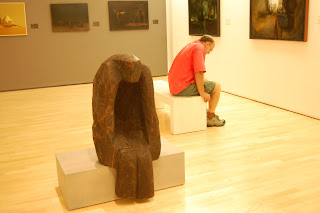 |
| by Branko Radic, 1972 (unintentional pose) |
CLICK HERE TO SEE MORE OF THE ART including a show of work by Kazimir Hraste.
After a quick stop to get our rental car, our next stop was the Gallery of Ivan Meštrović.
 |
| New Split |
 |
| Touchdown! |
Here are a couple of shots of the lawn and galleries:
CLICK HERE TO SEE MORE OF THE COLLECTION.
Just down the street, between the sea and an olive grove, is Meštrović's Chapel, which he bought as a 17th century summerhouse in 1939 and converted it into a place of peace and contemplation. The artwork is all his.
After a lunch stop (we had delicious fresh grilled fish) in Skradin at the entrance of Krka National Park,
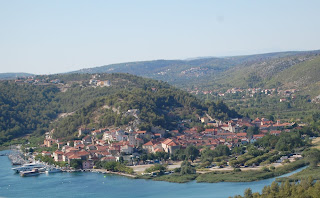 |
| Skradin |
And soon we were at Plitvice Lakes National Park:
OR CLICK HERE TO SEE SOME VIDEO.
That evening, our host Ivan spied me with my ritual beer out on the little front porch of our bungalow, and brought over a special hand-painted bottle containing his home-brewed slivovitz. He had a way of constantly refilling the small glasses and it was mighty tasty.
 |
| Ivan |
 |
| The Way |
The next day we drove west back to the coast and the almost-island of Istria. Still Croatia, but a world unto its own. Entrance was once again gained via a long tunnel through a mountain. Just over a thousand square miles in size, Istria has its own history and culture, and provides a unified community.
Our base was the little town of Roč in the northern section, but we wasted little time in driving to the far south to explore Pula.
 |
| The Arena in Pula, built from 27 BCE - 68 CE |
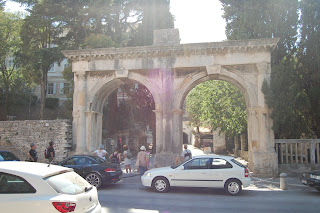 |
| Porta Gemina, 2nd century CE |
 |
| Triumphal Arch of Sergius, 29-27 BCE |
 |
| Temple of Augustus |
Pula has a long history of being a shipbuilding and naval base, first for the Romans and later for the Austro-Hungary Empire. James Joyce came to Pula in 1904/105 and taught English there.
 |
| sculpture by Mate Čvrljak |
There was even Art in the tourism office.
 |
| by Beti Kranjcevic |
Then we proceeded up along the coast. First stop, Fazana. Formerly a fishing village, tourists have taken over the joint as it is now the point of departure for boats going over to the Brioni Islands National Park. Marshall Tito is said to have spent six months a year in Fazana and the islands.
It's got the church:
 |
| Church of Sts Kosmos & Damian, 15th century |
And the alleyways and stairs,
Then I found this fountain not working, but couldn't miss the small fish design.
 |
| by Solidea Guerra |
And then at the waterfront I found Pilchard Park. Pilchard are sardines, hence the small fish design, and the theme of the other sculptures we found there.
 |
| Pilchard Park is on the left along the waterfront. |
 |
| by Robert Bencic |
 |
| by Marina Belos |
 |
| by Roberta Weissman Nagy |
 |
| by Lena Gersic |
 |
| by Igor Grgurevic |
It was just a short drive to St. Fosca's Church, outside Vodnjan, but a dusty one, as the roads were all dirt and rarely used. The signs were often misleading, but after a few attempts we did reach our goal: three drystone huts recently reconstructed from the ancient designs:
The next morning we began by going inside the old stone walls of the hilltop town of Roč, which was just down the street. It's really tiny.
 |
| Roman tombstone from 69 CE |
 |
| note the violin on the director's stand |
 |
| not a musical instrument |
To the west is another hill-topping citadel named Buzet, which is also the regional center.
 |
| city gate |
 |
| Parish Church of the Blessed Virgin Mary, 1784 |
There was one more of these towns to the south of Roč we went to visit. It is called Hum. Hum celebrates an earlier time when Glagolica was the old written language used in these parts.
There is the Glagolitic Alley where, between Roč and Hum, are eleven stone monuments dedicated to significant people and events, with the inscriptions in Croatian and Glagolica. I thought about trying to explain it here, but thought better of it. Here's what we found in Hum:
 |
| Stone Table Cyril and Methodius, planted two cypress trees symbolize the holy brothers. |
 |
| see the glagolica |
 |
| Uspon |
 |
| Hum. According to Guinness, the smallest city in the world. |
 |
| copper city doors with bull horn handles |
And a few sights along the way to Labin, near the Southeast coast.
The Mediterranean Sculpture Symposium brings artists from around the world to create sculptures just outside Labin. This year is the 40th edition. Though there was a scorching hot sun, I took pictures of every piece I could find.
The Mediterranean Sculpture Symposium brings artists from around the world to create sculptures just outside Labin. This year is the 40th edition. Though there was a scorching hot sun, I took pictures of every piece I could find.
There were still a couple of other sculptures in town,
 |
| Obluci by Josip Diminic, 1973-2000 |
Diminic was a famous sculptor who co-founded the Mediterranean Sculpture Symposium.
In the afternoon we headed to the shore at Rabac. Had a good time before returning to Roč.
We began the next day on the West coast at Vrsar in search of the Dušan Džamonja sculpture garden. At the waterfront, we found sculpture:
Then we found a sculpture park in what appeared to be an old mining operation right there near the waterfront.
CLICK HERE TO SEE MORE.
And then there was one more burst of sculpture as we left town.
Just outside of town was the Dušan Džamonja Sculpture Park. This was actually one of DD's homes. Born in Macedonia in 1928, he died in Zagreb in 2009. A successful sculptor, he began building this place in 1970. The park was free.
And then there was one more burst of sculpture as we left town.
Just outside of town was the Dušan Džamonja Sculpture Park. This was actually one of DD's homes. Born in Macedonia in 1928, he died in Zagreb in 2009. A successful sculptor, he began building this place in 1970. The park was free.
The next town up the coast was Funtana. Even this smallish town has an old town on a hill. Our target was the Galerija Zgor Murve for the In the Funtana Family exhibition. For this show residents have loaned some of their favorite artworks for viewing. A terrific idea.
 |
| Verdi by Izet Duze |
One more step up the coast is Poreč. Famous for the Byzantine Basilica of St. Euphrasia, we found another charming town with old walls and marble paving stones. There was a show at the Istrian Council House of the 52nd Annual Group Exhibit of Contemporary Art.
 |
| Euphrasian Basilica begun in 528 CE |
While the room was spectacular, the Art left me cold
But then again, we found a small restaurant right out in front of the gallery where we had a delicious pork stew and watched the sun set and the world go by.
It was too dark by the time we got to Novigrad, but that didn't stop us from shooting these two large pieces in a rotary there:
We drove through Slovenia and into Italy for our day trip to Trieste. The plan was to drive into Muggia and park the car in the smaller town and take a ferry into Trieste. Small but no less interesting:
I have been interested in Trieste for its role as the port city for the Austro-Hungary Empire; the emphasis we noted seemed to be on its Venetian past with a Nouveau twist.
Had lunch in the oldest coffee house in Trieste, Caffè Tommasino (1830). Hardly memorable.
Took an old tram up the hill to Villa Opicina. It also became a funicular.
And then we took a bus along the shore to Miramare Castle. (The bus was filled with bathers.) Once this was the home of Hapsburg scion Archduke Ferdinand Maximilian and his wife Charlotte of Belgium from 1856-60. Now people go there to see the opulent room furnishings.
Not our usual fare, but they advertised a special exhibition of paintings by Lucas Cranach the Elder, a favorite of Marie's. So we bought our tickets and hurried through a few rooms of furniture until we came to the special room. There were just three paintings comprising the entire show. Photos were not allowed, but I found these images online:
And then back in town we found a few more sculptures.
We walked up the Via Cavana and had some gelato (better than that in Croatia). Couldn't get into a chocolate shop that was recommended because it was inexplicably closed. But that was right on the way to the Museo Revoltella - Gallery of Modern Art.
Drawing its roots from the original Museo Revoltella (named for the financier Pasquale Revoltella) in 1872, the major physical changes here began in 1907 with the acquisition of a neighboring property and finished in 1990.
Here are a couple of pieces I shot:
CLICK HERE FOR MORE PHOTOS FROM THE MUSEUM.
We bid adieu to our Roč abode and headed into Slovenia. On the coast, just above the Croatian line is the first of three Forma Viva projects we would visit. This was near Portorož. Tucked up above a campground. This project began in 1961 by two Slovenian artists, namely Jakob Savinšek and Janez Lenassi. Sculptors from over thirty countries left over 120 stone artworks behind.
There was even a small group of sculptures there too.
CLICK HERE TO SEE MORE.
We continued across Slovenia to Kostanjevica na Krki, a cute village, home of the next Forma Viva location. Here, at Galeriji Božidar Jakac, all the sculptures are made of wood and inside the old monastery are galleries for various exhibitions from ancient to contemporary.
CLICK HERE TO SEE MORE OF THE EXHIBITIONS.
There were three weddings scheduled for the afternoon. We only caught one of them, beginning with the entrance to the courtyard.
It was a perfect afternoon and many took to the river.
And you never have to look far for another sculpture.
We enjoyed our two-hour drive through Slovenia, much of it along the Sava River, on our way to Maribor.
Maribor is a European Capitol of Culture in 2012, a very great honor. I think. One of the reasons is that it is also the site of a Forma Viva project. This one, however, was not confined to a park but was rather spread around town. Unfortunately, without a good map and more daylight, they were hard to find. We scouted around.
And of course there are always lots of interesting architectural features.
They were having a vintage car show when we arrived.
The best part of our visit was when all the bells in the city rang our for an extended period of time. It was quite magical.
We got out of town just before dark and drove the hour and a half to Zagreb and got a room there so we could return the car nice and early.
The sculpture kept on coming.
Our first stop was the Mimara Museum - the collections of Ante and Wiltrud Topic Mimara. There was a wide array of exhibits from prehistory to impressionist. A Reubens, a Delacroix, a Pissarro, a Serault.
Of special interest to us was a display explaining the excavation of the Apoxyomenos. That means that the subject was an athlete in the act of scraping sweat from his body. The second shot is of the statue as it was found under the sea.
Right across the street in the Franklin Delano Roosevelt Square, bicyclists were gathering before the start of the international bicycle race from Zagreb, capital of Croatia, to Ljubljana, capital of Slovenia.
We couldn't wait for it to begin as it was Sunday and museums have short hours. Plus we were faced with the prospect of the next day being Monday when all museums are closed. It was a pleasant walk to the Modern Gallery which faced on Zrinski Square. Housed in the Revival-style Vranyczany Palace, the museum offers an excellent selection of artworks from the 19th to the 21st century. Here are a few that I liked:
CLICK HERE TO SEE MORE FROM THE MODERN GALLERY.
We closed the place, naturally. Now there was time to find our new quarters, which was much more difficult than I expected. But we did it. Before we could leave Ban Josip Jelačić Square, we were treated to the ceremonial changing of the guard which is carried out by the Cravat Regiment.
Then we grabbed a tram to get to our place, which was in a fairly quiet residential neighborhood that was a six-seven block walk from the tram stop.
It rained for the first time in a few months here. Heavy at first and it was still raining lightly when we departed for the Museum of Contemporary Art.
When the weather is dry, visitors can slide down three stories in this artwork.
CLICK HERE FOR MORE PHOTOS.
We got to St. Mark's just as a mass was set to begin. I got a shot of one of Meštrović's pieces inside, but did not get any of Jozo Kljaković's frescoes that decorate the walls. The coats of arms on the church roof represent the Kingdoms of Croatia, Dalmatia, and Slovenia. Also facing St. Mark's Square are the Parliament and other important government buildings.
Back in town, they had a band playing in the main square and the whole town came out to socialize.
Friday night was a parade.
And on Saturday things got serious out at the Hippodrome. After several contestants did some traditional jumping, a line of mostly young girls, wearing white, paraded out onto the track and performed the same routine on horseback, from the oldest to the youngest. Then they ducked under the horse at the end. It was pretty cute.
There was also some more unusual competition.
First the group of about a dozen men on
horseback riding quickly attempted to hit a gong with a mace.
TO SEE MORE OF HER WORK, CLICK HERE.
I have been interested in Trieste for its role as the port city for the Austro-Hungary Empire; the emphasis we noted seemed to be on its Venetian past with a Nouveau twist.
 |
| Plaza of the Unity of Italy |
 |
| Grande Canal |
Had lunch in the oldest coffee house in Trieste, Caffè Tommasino (1830). Hardly memorable.
Took an old tram up the hill to Villa Opicina. It also became a funicular.
Not our usual fare, but they advertised a special exhibition of paintings by Lucas Cranach the Elder, a favorite of Marie's. So we bought our tickets and hurried through a few rooms of furniture until we came to the special room. There were just three paintings comprising the entire show. Photos were not allowed, but I found these images online:
 |
| Venice and Cupid |
 |
| Diana and the Nymphs at bath surprised by Actaeon |
And then back in town we found a few more sculptures.
We walked up the Via Cavana and had some gelato (better than that in Croatia). Couldn't get into a chocolate shop that was recommended because it was inexplicably closed. But that was right on the way to the Museo Revoltella - Gallery of Modern Art.
Drawing its roots from the original Museo Revoltella (named for the financier Pasquale Revoltella) in 1872, the major physical changes here began in 1907 with the acquisition of a neighboring property and finished in 1990.
Here are a couple of pieces I shot:
 |
| Sphere No. 3 by Arnoldo Pomodoro, 1964 |
 |
| Crown of St. John by Dyalma Stultus, 1930 |
CLICK HERE FOR MORE PHOTOS FROM THE MUSEUM.
We bid adieu to our Roč abode and headed into Slovenia. On the coast, just above the Croatian line is the first of three Forma Viva projects we would visit. This was near Portorož. Tucked up above a campground. This project began in 1961 by two Slovenian artists, namely Jakob Savinšek and Janez Lenassi. Sculptors from over thirty countries left over 120 stone artworks behind.
Heading east, not far outside of Trieste, we saw signs for the Lipizzaner Stud Farm at Lipica. First we just came upon the herd:
There was even a small group of sculptures there too.
CLICK HERE TO SEE MORE.
We continued across Slovenia to Kostanjevica na Krki, a cute village, home of the next Forma Viva location. Here, at Galeriji Božidar Jakac, all the sculptures are made of wood and inside the old monastery are galleries for various exhibitions from ancient to contemporary.
CLICK HERE TO SEE MORE OF THE EXHIBITIONS.
There were three weddings scheduled for the afternoon. We only caught one of them, beginning with the entrance to the courtyard.
Inside the old sanctuary, there was a guitar and flute, along with the artwork of Tomislav Buntak.
The guests cheered bride and groom, and followed them out to a small reception with an accordion player.
Before we left, we found the old wine cellar, and one more work of Art.
 |
| Spatial Systems by Nusa Lapajne Curin |
It was a perfect afternoon and many took to the river.
And you never have to look far for another sculpture.
We enjoyed our two-hour drive through Slovenia, much of it along the Sava River, on our way to Maribor.
Maribor is a European Capitol of Culture in 2012, a very great honor. I think. One of the reasons is that it is also the site of a Forma Viva project. This one, however, was not confined to a park but was rather spread around town. Unfortunately, without a good map and more daylight, they were hard to find. We scouted around.
The sculpture here was supposed to be made of concrete, so I suppose these are not part of Forma Viva.
 |
| This one was Forma Viva, perhaps. And this: |
 |
| by Marko Jakše |
And of course there are always lots of interesting architectural features.
They were having a vintage car show when we arrived.
The best part of our visit was when all the bells in the city rang our for an extended period of time. It was quite magical.
We got out of town just before dark and drove the hour and a half to Zagreb and got a room there so we could return the car nice and early.
The sculpture kept on coming.
Our first stop was the Mimara Museum - the collections of Ante and Wiltrud Topic Mimara. There was a wide array of exhibits from prehistory to impressionist. A Reubens, a Delacroix, a Pissarro, a Serault.
 |
| A Rembrandt |
 |
| A Renoir |
 |
| A Manet |
Of special interest to us was a display explaining the excavation of the Apoxyomenos. That means that the subject was an athlete in the act of scraping sweat from his body. The second shot is of the statue as it was found under the sea.
 |
| Beba from Bizovac by Zlatko Bourek, 1980 |
 |
| Young Patrician Women by Vlaho Bukovac, 1890 |
 |
| Female Nude by Sava Šumanović, 1923 |
 |
| Old Mill by Vladimir Varlaj, ca 1930 |
CLICK HERE TO SEE MORE FROM THE MODERN GALLERY.
We closed the place, naturally. Now there was time to find our new quarters, which was much more difficult than I expected. But we did it. Before we could leave Ban Josip Jelačić Square, we were treated to the ceremonial changing of the guard which is carried out by the Cravat Regiment.
It was quiet at the museum. Firstly, it is not close to the center of town. It's what is called New Zagreb. Highrise apartment buildings, shopping malls. And an Art museum. The gloom of the rain didn't add to the atmosphere.
The museum is quite large, as you can see, and had a good combination of permanent collection and temporary exhibitions. Here are a few pieces I liked:
 |
| White Departure by Edo Murtic, 1964 |
 |
| Composition by Vladmir Kristi, 1953 |
When the weather is dry, visitors can slide down three stories in this artwork.
CLICK HERE FOR MORE PHOTOS.
Here are scenes from around Zagreb:
 |
| The Cathedral of the Assumption of the Blessed Virgin Mary |
 |
| hardware store |
 |
| St Mary's steeple and doorway (below) |
 |
| Kumica Barica by Stjepan Gracan, 2006 |
 |
| statue of Marija Jurić Zagorka by Stjepan Gracan |
 |
| World's Shortest Funicular |
 |
| Strossmayer Art Colony |
We got to St. Mark's just as a mass was set to begin. I got a shot of one of Meštrović's pieces inside, but did not get any of Jozo Kljaković's frescoes that decorate the walls. The coats of arms on the church roof represent the Kingdoms of Croatia, Dalmatia, and Slovenia. Also facing St. Mark's Square are the Parliament and other important government buildings.
This (below) is the Stone Gate built in 1647 (redone in 1760 but not since). There was sort
of an outdoor chapel just inside, complete with pews.
 |
| Dora Krupiceva (heroine in a novel) by Ivo Kerdic |
And just a few steps away was this statue of St. George after slaying the dragon. He looks so serene and the tip of the bronze lance is still imbedded in the stone dragon. They both look so reposeful.
And a little more Art:
We began the next day at the Art Pavilion overlooking the statue of King Tomislav and the train station.
Unfortunately the building was empty as they were between exhibitions, but they let me take a picture of the interior.
We were also surprised by this nifty method of repairing Old Masters.
The Academy for Arts and Sciences was just up the street. This is home to the Strossmayer Gallery, first opened in November 1884. There were paintings by Tintoretto, Bosch, and El Greco. Did not find the promised Fra Angelica. Did see the ugliest Botticelli ever. The lighting, which did not always come on, was terrible. Much of the artwork not even viewable. There was even a Rembrandt there but it was
so dark I couldn't make out the subject of the painting. I hate to be negative but really.
 |
| by Sandro Botticelli |
 |
| Mary Magdalene by El Greco |
 |
| by Pieter Breughel |
We were also surprised by this nifty method of repairing Old Masters.
We went to the Upper City to find the Ivan Meštrović Museum. You may recall reading this name before, but I guess I can't overemphasize the impact this one artist has on a nation. This is where he bought three properties in the center of the old city and converted them for his use until 1942 when he moved to Rome, then Switzerland, then the United States. In 1928 he did a pair of equestrian statues here for Chicago's Grant Park and then did work at Syracuse and Notre Dame Universities. He died in South Bend in 1969.
The space in Zagreb is much more intimate than that of the Split mansion so you can almost imagine him living and working there. About every inch of the place was filled with examples of Meštrović's work. Here are a couple:
 |
| Majka - Mother |
 |
| Self-Portrait |
He also did this little beauty overlooking Ban Josip Jelačić Square
And something I did not discover until we got home was that Meštrović also designed this building now used by the Croatian Association of Artists.
And then there was some wall Art. CLICK HERE TO SEE VIDEO.
I'm sure we could have found more, but it was time to leave Zagreb. We took a six-plus hour train ride to Belgrade. There (actually at the airport) we rented a car for the last few days. It just gave us the flexibility we needed.
Our first stop was Jagodina to see the Museum of Naïve and Marginal Art.
The museum was pretty wonderful. I wish I could describe the atmosphere in Jagodina that Thursday. Everybody seemed to be out walking on the sidewalks. Talking, eating, shopping. There were just people everywhere. And after all that we found a quiet place with a beautiful old building and carved stone on the grounds.
These were done by Ilija Filipović who had a show on the top floor called Man and Stone - Fellow Travelers Through Time.
CLICK HERE TO SEE MORE.
The main floor had remains of previous shows cramming every inch of space, but they would not allow photos. The basement was filled with more Art by artists with limited or no training.
The town was fun. We walked through the market, even buying socks, plums, and paprika.
Found this church:
Enjoyed walking around. There was one tiny shop that sold only the few flavors of soda that they made in the back. It must have been a local favorite because the place was jumping.
I'm sure we could have found more, but it was time to leave Zagreb. We took a six-plus hour train ride to Belgrade. There (actually at the airport) we rented a car for the last few days. It just gave us the flexibility we needed.
Our first stop was Jagodina to see the Museum of Naïve and Marginal Art.
The museum was pretty wonderful. I wish I could describe the atmosphere in Jagodina that Thursday. Everybody seemed to be out walking on the sidewalks. Talking, eating, shopping. There were just people everywhere. And after all that we found a quiet place with a beautiful old building and carved stone on the grounds.
These were done by Ilija Filipović who had a show on the top floor called Man and Stone - Fellow Travelers Through Time.
CLICK HERE TO SEE MORE.
The main floor had remains of previous shows cramming every inch of space, but they would not allow photos. The basement was filled with more Art by artists with limited or no training.
 |
| Jubucilo and Momcilo by Sava Sekulic, 1974. |
 |
| Church of Peter and Paul |
 |
| interior |
Our final stop was a couple hours north in Požarevac for the
49th Equestrian Event.
Before we saw any horses, however, we drove out of town to the
excavations of a Roman settlement called Viminacium near the Danube River. We were told that it was so important that virtually every Roman emperor stayed or visited there. It was very interesting, of course, but what really took Marie's
breath away was the enormous pit where they were strip mining for coal and the
huge power plants bordering the excavation.
Back in town, they had a band playing in the main square and the whole town came out to socialize.
The next day the horse events began with some kind of show
competition. There were trophies and
unsaddled horses were paraded around a ring, but there was little else that I
recognized. There seemed to be
multiple breeds in each class. But it
was still fun to watch.
Friday night was a parade.
And on Saturday things got serious out at the Hippodrome. After several contestants did some traditional jumping, a line of mostly young girls, wearing white, paraded out onto the track and performed the same routine on horseback, from the oldest to the youngest. Then they ducked under the horse at the end. It was pretty cute.
There were races of harness and thoroughbred horses. A little more down home. I saw no windows for placing bets, so they
may have been racing for trophies and wreaths.
But it was fun watching everyone cheering for a horse or rider they
probably knew. Notice that they run the opposite direction than here.
There was also some more unusual competition.
Then they shot arrows at a target suspended high in the
air.
The target for the javelin throwing was closer to the
ground.
Lastly, each contestant used a saber to cut a dowel
sideways, slice a watermelon on a pedestal vertically, and stick the point into a
target close to the ground.
The winner
gets to wear the red cape in next year’s parade.
Even here there was Art.
In addition to meeting an artist whose work was being shown.
We discovered the home of another artist whose work we had
seen earlier in the trip. Milina
Pavlović Barilli was the only Croatian to illustrate the covers of Vogue, Town & Country, and other magazines, back in 1940.
We saw more of her work in Belgrade soon after we
arrived. Her celebrity subjects
included Anna Pavlova, Rudoph Valentino, and Josephine Baker. Melina died in New York from a horse-riding accident when just 36.
TO SEE MORE OF HER WORK, CLICK HERE.
We left early the next morning to go back to Belgrade and home.










































